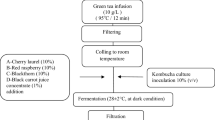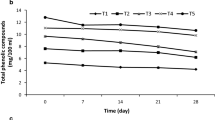Abstract
Matching the general trend of replacing synthetic additives with healthier natural products, the present research studies the effects of different concentrations of chokeberry extract which substitute carmoisine dye in jelly candies. Also, the colour and antioxidant properties of the aforementioned extract and their changes at various pH and in presence of different mineral salts from foods are analysed. The phenolic content of the extract was determined using HPLC and spectrophotometric methods. A high concentration of polyphenols was found in the chokeberry extract, of which around 97% were flavonoids. Catechin, epicatechin, ferulic acid and its methyl esther, protocatechuic, gallic and para-hydroxybenzoic acids were the major phenolics identified in the extract. The total antioxidant activity decreased in acidic media, while close-to-neutral and alkaline pH values did not exhibit any effect on this parameter. Furthermore, the green/red colour parameter, the chroma and the hue angle were enhanced in the most acidic media (pH 2.3 and 3.5). From the studied salts, CaCl2 and KNO3 had the most significant effects on colour. The chokeberry extract proved to be suitable as replacement of carmoisine dye in jelly candies, as the physicochemical and microbiological properties comply with the regulated requirements. More than that, the extract improved the antioxidant and sensory properties of jellies in all studied concentrations and the best total sensory score was obtained for 1.5% extract. After 5 and 50 days of storage, the microbiological properties were improved in candies prepared with aronia extracts compared to carmoisine, as the total viable count registered important diminutions.


Similar content being viewed by others
References
Altukaya A, Gokmen V, Skibsted LH (2016) pH dependent antioxidant activity of lettuce (L. sativa) and synergism with added phenolic antioxidants. Food Chem 190:25–32
Bermudez-Soto M-J, Tomas-Barberan F-A, Garcia-Conesa M-T (2007) Stability of polyphenols in chokeberry (Aronia melanocarpa) subjected to in vitro gastric and pancreatic digestion. Food Chem 102:865–874
Borzelleca JF, Hallagan JB (1988) Chronic toxicity/carcinogenicity studies on FD, C yellow no.5 (tartrazine) in rats. Food Chem Toxic 26(3):179–187
Brand-Williams W, Cuvelier ME, Berset C (1995) Use of free radical method to evaluate antioxidant activity. Lebensm Wiss Technol 28:25–30
Calalb T (2008) Comparative phenolic potential of the callus masses and the Aronia melanocarpa fruits. Elliot Rev Farm 1(4):23–28 (in Romanian)
Cristea E, Sturza R, Jauregi P, Niculaua M, Ghendov-Moşanu A, Patras A (2019) Influence of pH and ionic strength on the color parameters and antioxidant properties of an ethanolic red grape marc extract. J Food Biochem 43(4):e12788
Demir N, Yioldiz O, Alpaslan M, Hayaloglu AA (2014) Evaluation of volatiles, phenolic compounds and antioxidant activities of rose hip (Rosa L.) fruits in Turkey. LWT Food Sci Technol 57(1):126–133
Fellin W (2005) Analyzing uncertainty in engineering. Springer, Berlin
Filimon RV, Filimon RM, Patraş A, Rotaru L (2020) Grape quality and ornamental potential of interspecific cultivars for temperate climate vineyards. J Hortic Sci Biotechnol 95(1):65–75
G. D. of R. M. no. 204 from March 11, 2009 regarding the approval of Technical Regulation on Confectionery. Official Monitor of the Republic of Moldova, 11.03.2009, no. 57-58 (in Romanian)
G. D. of R. M. no. 221 from March 16, 2009 regarding the approval of rules on microbiological criteria for foodstuffs. Official Monitor of the Republic of Moldova, 24.03.2009, no. 59-61, art. 272 (in Romanian)
Ghendov-Mosanu A, Sturza R, Chiriţa E, Patras A (2016) Valorization of winemaking by-products in the production of jelly candies. Ital Food Mater Mach 04(2016):12–15
Giusti MM, Wrolstad RE (2001) Characterisation and measurement of anthocyanins by UV-visible spectroscopy. Current protocols in food analytical chemistry, F1.2.1-F1.2.13
Jabbari M, Gharib F (2012) Solvent dependence on antioxidant activity of some water-insoluble flavonoids and their cerium(IV) complexes. J Mol Liq 168:36–41
Kulling SE, Rawel HM (2008) Chokeberry (Aronia melanocarpa)—a review on the characteristic components and potential health effects. Planta Med 74:1625–1634
Ngo T, Zhao Y (2009) Stabilization of anthocyanins on thermally processed red d’Anjou pears through complexation and polymerization. LWT Food Sci Technol 42:1144–1152
Official Methods of Analysis of AOAC International (2016), 20th edn
OIV (2006) Method OIV-MA-AS2-11: R2006, Determination of chromatic characteristics according to CIELab. Compendium of international analysis of methods—OIV chromatic characteristics, 1–16
Ovaskainen ML, Torronen R, Koponen JM, Sinkko H, Hellstrom J, Reinivuo HE (2008) Dietary intake and major food sources of polyphenols in Finnish adults. J Nutr 138(3):562–566
Patras A (2019) Stability and colour evaluation of red cabbage waste hydroethanolic extract in presence of different food additives or ingredients. Food Chem 275:539–548
Polonio ML, Peres F (2009) Consumption of food additives and its health effects: challenges for Brazilian public health. Cad Saude Publica 25(8):1653–1666 (in Portuguese)
Puupponen-Pimia R, Nohynec L, Alacomy H, Oksman-Caldentey K (2008) The action of berry phenolics against human intestinal pathogens. Bio Factors 23(4):243–251
Re R, Pellegrini N, Proteggente A, Pannala A, Yang M, Rice-Evans C (1999) Antioxidant activity applying an improved ABTS radical cation decolorization assay. Free Radic Biol Med 26:1231–1237
Regulation of EC no. 1441/2007 amending Regulation of EC no. 2073/2005 on microbiological criteria for foodstuffs (2007) Official Journal of the European Union, L 322, December 7
Ribereau-Gayon P, Glories Y, Maujean A, Dubourdieu D (2006) Handbook of enology, vol 2. The chemistry of wine stabilization and treatments. Wiley, Chichester
Saeedeh AD, Vishlakshi Devi D, Urooj A (2007) Evaluation of antioxidant activity of some plant extracts and their heat, pH and storage stability. Food Chem 100:1100–1105
Savikin K, Zdunic G, Jankovic T, Godevac D, Stanoikovic T, Plievliakusic D (2014) Berry fruit teas: phenolic composition and cytotoxic activity. Food Res Int 62:677–683
Savvin P, Bolotov V (2008) Investigation of antioxidant properties of jelly marmalade. Chem Plant Raw Mater 4:177–179 (in Russian)
Scafetta N (2001) An entropic approach to the analysis of time series. Dissertation University of North Texas
Sikora E, Cieslik E, Topolska K (2008) The sources of natural antioxidants. Acta Sci Pol Technol Aliment 7(1):5–17
Singleton VL, Rossi JA (1965) Colorimetry of total phenolics with phosphomolybdic-phosphotungstic acid reagents. Am J Enol Vitic 16:144–158
Spranger I, Sun B, Mateus AM, de Freitas V, Ricardo-da-Silva J (2008) Chemical characterization and antioxidant activities of oligomeric and polymeric procyanidin fractions from grape seeds. Food Chem 108:519–532
SR ISO 6658:2017 (2017) Sensory analysis—methodology—general guidance
Sturza R, Deseatnicova O (2012) Physico-chemical and colloidal processes in food systems. Monograph UTM, Chisinau (in Romanian)
Tamer C, Incedayi B, Copur O, Karinca M (2013) A research on the fortification applications for jelly confectionery. J Food Agric Environ 11(2):152–157
Tolic M-T, Jurcevic I-L, Krbavcic I-P, Markovic K, Vahcic N (2015) Phenolic content, antioxidant capacity and quality of chokeberry (Aronia melanocarpa) products. Food Technol Biotechnol 53–2:171–179
Wangesteen H, Braunlich M, Nikolic V, Malterud KE, Slimestad R, Barsett H (2014) Anthocyanins, proanthocyanidins and total phenolics in four cultivars of aronia: antioxidant and enzyme inhibitory effects. J Funct Foods 7:746–752
Acknowledgements
Aliona Ghendov-Mosanu and Elena Cristea were recipients of Eugen Ionescu scholarships offered by AUF and the Ministry of Foreign Affairs of Romania. The authors would also like to thank the project AUF BECO-2012-53-U-56135FT205. This work was benefited from support through the Projects: AUF - DRECO - S0446 SaIN (Agence Universitaire de la Francophonie, 2017-2019) and 16.80013.5107.22/Ro “The substitution of synthetic food additives with bioactive components extracted from natural renewable resources” (Academy of Science of Moldova, Moldovan Government and UEFISCDI, BM 35/2016 PN III-P3-220).
Author information
Authors and Affiliations
Corresponding author
Ethics declarations
Conflict of interest
The authors have declared no conflict of interest.
Additional information
Publisher's Note
Springer Nature remains neutral with regard to jurisdictional claims in published maps and institutional affiliations.
Rights and permissions
About this article
Cite this article
Ghendov-Mosanu, A., Cristea, E., Sturza, R. et al. Synthetic dye’s substitution with chokeberry extract in jelly candies. J Food Sci Technol 57, 4383–4394 (2020). https://doi.org/10.1007/s13197-020-04475-6
Revised:
Accepted:
Published:
Issue Date:
DOI: https://doi.org/10.1007/s13197-020-04475-6




